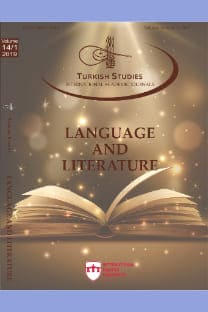CRIME IN THE OLD CAPITAL: HISTORIC ISTANBUL IN AHMET ÜMİT’S A MEMENTO FOR ISTANBUL
This article discusses the complex and ambiguous images of Istanbul in a work of contemporary Turkish fiction: Ahmet Ümit’s İstanbul Hatırası [A Memento for Istanbul] (2010). It aims to show how the author utilizes the literary representation of various architectural monuments and the historical figures who erected them in order to emphasize the city’s ethnic, cultural, architectural and linguistic complexity. Within the framework of discussions on the relationship between the flâneur figure and the modern detective, the study argues that although the novel is fundamentally a contemporary murder mystery, in which the detectives stroll through the streets of an urban city to find a serial killer, the portrayals of both Istanbul’s distant history during the Byzantium, Roman, Byzantine and Ottoman periods and the protagonist’s memories of the culturally diverse neighborhood of his childhood occupy a substantial place. Accordingly, Ümit, a leading contemporary Turkish detective novelist, effectively uses the intermingling of a contemporary detective mystery with stories of the architectural history of Istanbul over centuries and the depiction of the old city during the protagonist’s childhood to challenge the dominant representation of Istanbul in Turkish fiction. This narrative strategy in Ümit’s novel turns Istanbul into a palimpsest in which layers of architectural monuments, memories, histories, stories, and cultures from different periods come together to define its contemporary urban space. By doing this, A Memento for Istanbul also provides profound insights into our understanding of Istanbul’s complex and multiple past through the author’s skillful blending of depictions of the contemporary urban city with those of the ancient capital. The novel thus informs the reader not only about the complexity, diversity and heterogeneity of historic Istanbul, but also appeals to the reader to preserve its cosmopolitan heritage.
ESKİ BAŞKENTTE CİNAYET: AHMET ÜMİT’İN İSTANBUL HATIRASI’NDA TARİHSEL İSTANBUL
Bu makale, Ahmet Ümit’in İstanbul Hatırası (2010) romanında cinayet ve şehir ilişkisi ekseninde, çeşitli mimari anıtların ve onların banisi tarihi kişiliklerin yazınsal temsilinden şehrin kültürel çeşitliliğini vurgulamak üzere nasıl yararlandığını inceliyor. Her ne kadar Ümit’in eseri özünde dedektiflerin seri katillerin peşinde şehrin caddelerini arşınladığı modern bir polisiye roman olsa da anlatıda hem İstanbul’un Byzantion, Roma, Bizans ve Osmanlı dönemlerine ait uzak geçmişinin hem de roman başkişisinin çocukluğunun kültürel çeşitlilik sergileyen semtine ait anılarının tasviri önemli bir yer tutar. Çalışma, flâneur figürü ile modern dedektif arasındaki münasebet üzerine tartışmalar çerçevesinde, kentin sokaklarını arşınlayan ana kahramanın sürekli modern şehrin kentsel manzarasını oluşturan mimari anıtlarını gözlemlediği bir anlatı yaratarak romancının İstanbul’un geçmişine ilişkin karmaşık katman ve dokuları açığa çıkardığını ileri sürüyor. Bu doğrultuda roman, İstanbul’u kolektif anlatılarla bireysel anıların kesiştiği, tarihî yapılarla çağdaş kent peyzajının yan yana yer alışı gibi farklı dönemlerden farklı kültürlerin harmanlandığı bir palimpseste dönüştürür. Romanda baş komiser Nevzat, çağdaş okur için şehri mütemadiyen gözlemleyen, şehrin mimari yapılarının öykülerini yeniden keşfeden ve anlatan bir hikâye anlatıcısı ve geçmişle şimdi arasında bir arabulucu işlevi görüyor. Böylelikle, İstanbul’un karmaşık ve çok çeşitli geçmişine ilişkin kavrayışımıza derin bir vuzuh sağlayan roman, İstanbul’un manzarasının asırlar boyunca sürekli nasıl yenilendiğini, yıkıldığını ve yeniden biçimlendirildiğini betimlerken kentin geçmişiyle ilişkimizi yeniden değerlendirmemizi olanaklı kılıyor.
___
Auster, P. (1988). The New York trilogy. London: Faber and Faber.Baudelaire, C. (2010). The painter of modern life and other essays (J. Mayne, Trans.). London: Phaidon.
Benjamin, W. (1999). Charles Baudelaire: A lyric poet in the era of high capitalism (H. Zohn, Trans.). London: Verso.
Birkerts, S. (1983). Walter Benjamin, Flâneur: A flanerie. The Iowa Review, 13(3-4), 164-179. doi:10.17077/0021-065x.2961
Boutin, A. (2012, 07). Rethinking the flâneur: flânerie and the senses. Dix-Neuf, 16(2), 124-132. doi:10.1179/dix.2012.16.2.01
Boym, S. (2002). The future of nostalgia. New York: Basic Books, a member of the Perseus Books Group.
Certeau, M. D. (1988). The practice of everyday life (S. Rendall, Trans.). Berkeley: University of California Press.
Dickens, R. (2004, 26 April). An eye on the city: The detective figure in Benjamin, Kracauer and Jameson. Retrieved from http://www.aughty.org/pdf/eye_on_city.pdf
Harding, D. (2004). Writing the city: Urban visions and literary modernism. New York and London: Routledge.
Massey, D. (1999). On space and the city. In D. Massey et al. (Eds.), City worlds (pp. 151-174). New York and London: Routledge.
Parsons, D. L. (2003). Streetwalking the metropolis: Women, the city and modernity. New York and London: Oxford University Press.
Pogossian, T. (2016). The art of walking in space and time: The quest for London. In K. Benesch & F. Specq (Eds.), Walking and the aesthetics of modernity (pp. 129-140). New York: Palgrave Macmillan. doi:10.1057/978-1-137-60364-7_9
Sennett, R. (1996). Flesh and stone: The body and the city in western civilization. New York and London: W. W. Norton & Company.
Ümit, A. (2010). İstanbul hatırası. İstanbul: Everest.
Ümit, A. (2011). A memento for Istanbul (R. Jobanputra, Trans.). Istanbul: Everest.
- ISSN: 2667-5641
- Yayın Aralığı: Yılda 4 Sayı
- Başlangıç: 2006
- Yayıncı: ASOS Eğitim Bilişim Danışmanlık Otomasyon Yayıncılık Reklam Sanayi ve Ticaret LTD ŞTİ
Sayıdaki Diğer Makaleler
1967-1970 YILLARINDAKİ DİLDE SADELEŞME VE AKADEMİ TARTIŞMALARININ TÜRK KÜLTÜRÜ DERGİSİNE YANSIMALARI
ATTİLÂ İLHAN’IN ŞİİRLERİNDE MÜŞTEREK ARAPÇA KELİMELER
ESKİ BAŞKENTTE CİNAYET: AHMET ÜMİT’İN İSTANBUL HATIRASI’NDA TARİHSEL İSTANBUL
SÜLEYMÂN-NÂME’DE MİTOLOJİK BİR UNSUR OLARAK DÎVLER
YABANCI DİL OLARAK TÜRKÇE DERS KİTAPLARINDA SOMUT OLMAYAN KÜLTÜREL MİRAS UNSURLARININ İNCELENMESİ
KLÂSİK TÜRK EDEBİYATINDA ŞEHBENDER
TÜRKMEN TÜRKÇESİNDE NOKTALAMA İŞARETLERİNİN KULLANIMI
ÇOCUK KİTAPLARINI ÇÖZÜMLEMEYE YÖNELİK BİR UYGULAMA: SAMED BEHRENGİ VE KÜÇÜK KARA BALIK ÖRNEĞİ
SEYİT ATEŞ, Kasım YILDIRIM, Fatih Çetin ÇETİNKAYA
